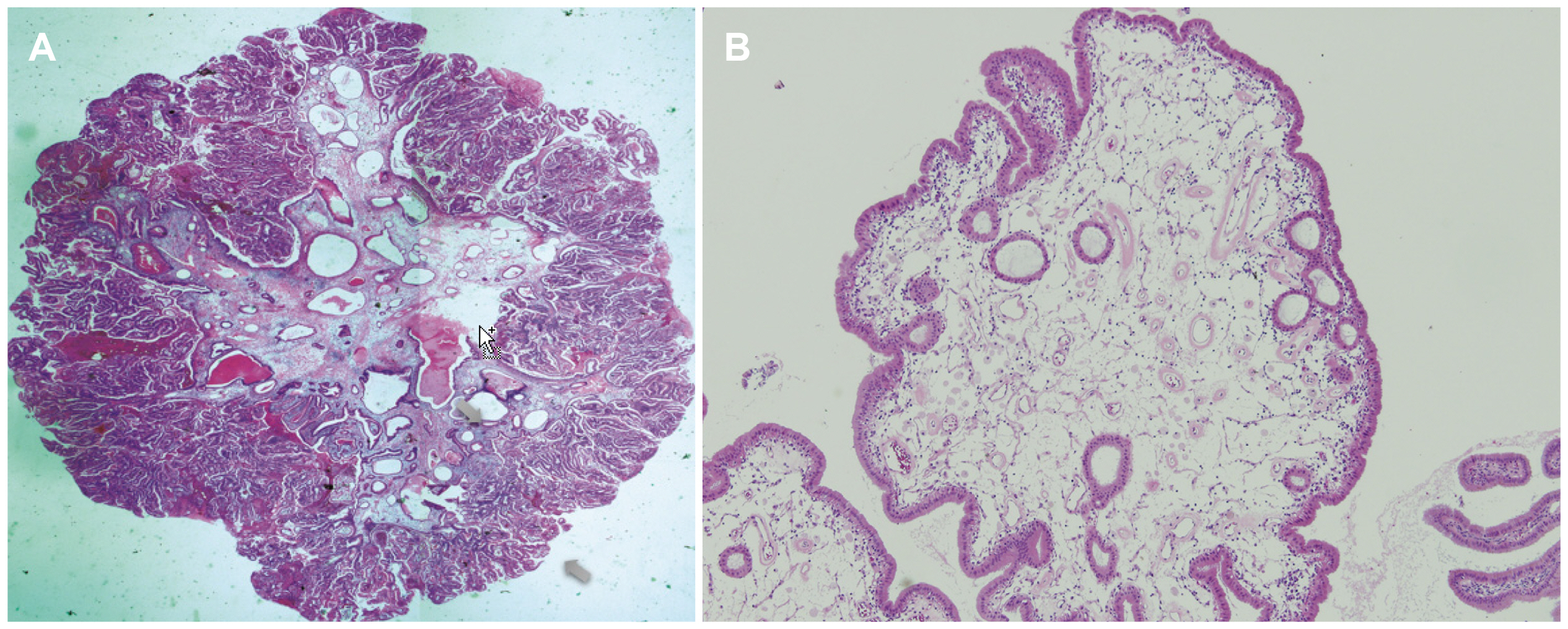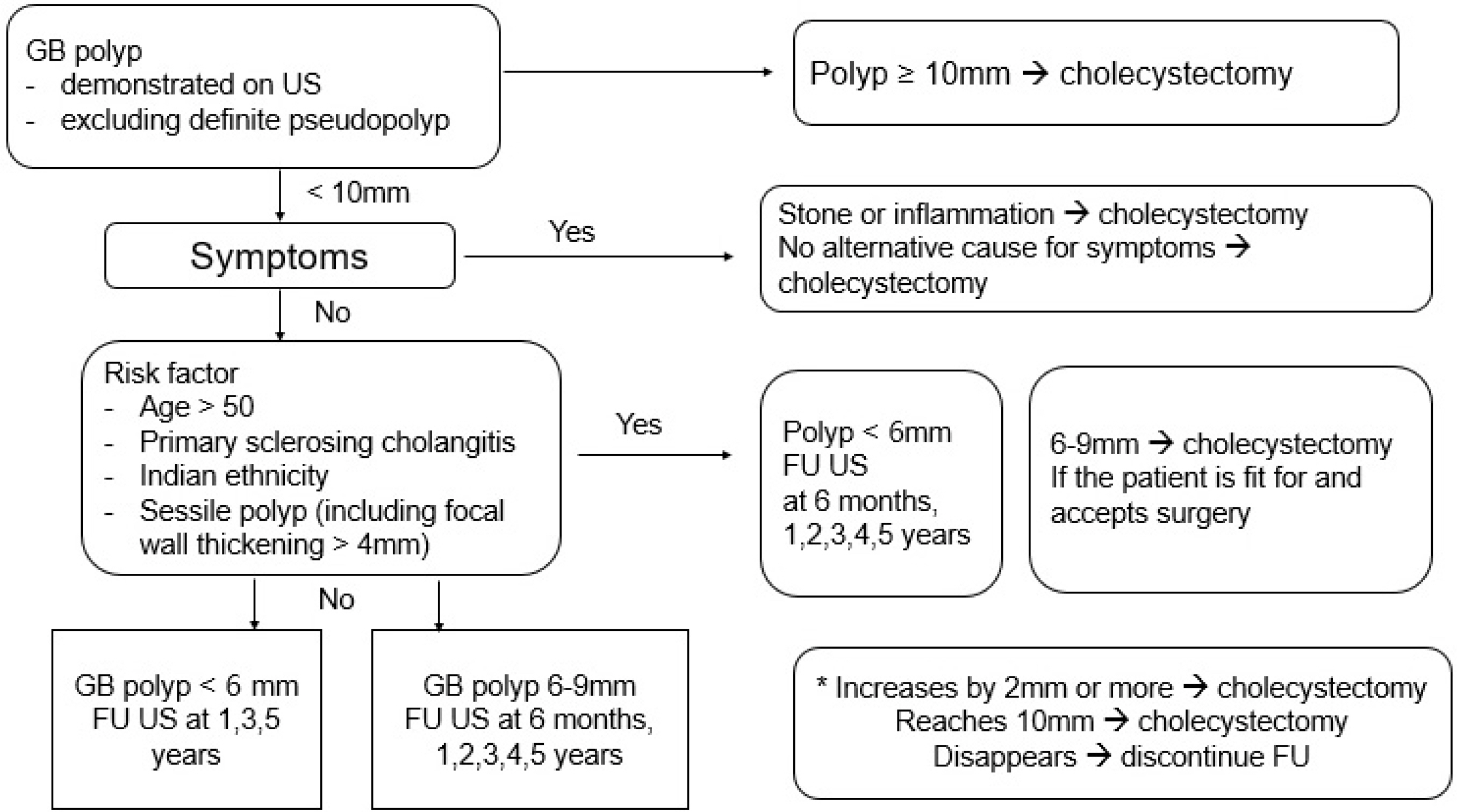Korean J Gastroenterol.
2020 Sep;76(3):102-107. 10.4166/kjg.2020.76.3.102.
Recent Updates on Diagnosis, Treatment, and Follow-up of Gallbladder Polyps
- Affiliations
-
- 1Department of Internal Medicine, Gangnam Severance Hospital, Yonsei University College of Medicine, Seoul, Korea
- KMID: 2506667
- DOI: http://doi.org/10.4166/kjg.2020.76.3.102
Abstract
- A gallbladder (GB) polyp is an elevation of the GB mucosa that protrudes into the GB lumen. GB polyps have an estimated prevalence of 0.3-9.5% and can be divided into neoplastic (true) polyps and nonneoplastic polyps (pseudopolyps). Pseudopolyps are most commonly cholesterol polyps but also include focal adenomyomatosis and inflammatory polyps with no malignant potential. Neoplastic polyps, however, can be benign or malignant. Benign polyps are most commonly adenomas, while malignant polyps are usually adenocarcinoma. Transabdominal ultrasonography is the main radiological modality used for diagnosing and surveilling GB polyps. On the other hand, because it is difficult to diagnose GB polyps before surgery, alternative imaging modalities, such as endoscopic ultrasound, are being further evaluated. The current guidelines recommend cholecystectomy for GB polyps ≥ 10 mm in size as well as suboptimal sized GB polyps (6-9 mm) with other risk factors, including age >50, sessile, and symptoms. The quality of the evidence behind this practice is relatively low. Therefore, this review identifies the current gaps in the available evidence and guidelines and introduces methods that can help make decisions regarding patients who require a cholecystectomy or follow-up.
Figure
Reference
-
1. Cho JH, Park JY, Kim YJ, et al. 2009; Hypoechoic foci on EUS are simple and strong predictive factors for neoplastic gallbladder polyps. Gastrointest Endosc. 69:1244–1250. DOI: 10.1016/j.gie.2008.10.017. PMID: 19249773.
Article2. Lee ES. 2014; Recent updates on the diagnosis and management of gallbladder polyps. Korean J Pancreas Biliary Tract. 19:64–70. DOI: 10.15279/kpba.2014.19.2.64.
Article3. Bang S. 2009; Natural course and treatment strategy of gallbladder polyp. Korean J Gastroenterol. 53:336–340. DOI: 10.4166/kjg.2009.53.6.336. PMID: 19556839.
Article4. Wiles R, Thoeni RF, Barbu ST, et al. 2017; Management and follow-up of gallbladder polyps : joint guidelines between the European Society of Gastrointestinal and Abdominal Radiology (ESGAR), European Association for Endoscopic Surgery and other Interventional Techniques (EAES), International Society of Digestive Surgery - European Federation (EFISDS) and European Society of Gastrointestinal Endoscopy (ESGE). Eur Radiol. 27:3856–3866. DOI: 10.1007/s00330-017-4742-y. PMID: 28185005. PMCID: PMC5544788.5. Lee KB. 2018; Histologic and molecular pathogenesis of gallbladder cancer. Korean J Pancreas Biliary Tract. 23:1–6. DOI: 10.15279/kpba.2018.23.1.1.
Article6. Park CH, Chung MJ, Oh TG, et al. 2013; Differential diagnosis between gallbladder adenomas and cholesterol polyps on contrast-enhanced harmonic endoscopic ultrasonography. Surg Endosc. 27:1414–1421. DOI: 10.1007/s00464-012-2620-x. PMID: 23233003.
Article7. Choi JH, Seo DW, Choi JH, et al. 2013; Utility of contrast-enhanced harmonic EUS in the diagnosis of malignant gallbladder polyps (with videos). Gastrointest Endosc. 78:484–493. DOI: 10.1016/j.gie.2013.03.1328. PMID: 23642490.
Article8. Bhatt NR, Gillis A, Smoothey CO, Awan FN, Ridgway PF. 2016; Evidence based management of polyps of the gall bladder: a systematic review of the risk factors of malignancy. Surgeon. 14:278–286. DOI: 10.1016/j.surge.2015.12.001. PMID: 26825588.
Article9. Kwon W, Jang JY, Lee SE, Hwang DW, Kim SW. 2009; Clinicopathologic features of polypoid lesions of the gallbladder and risk factors of gallbladder cancer. J Korean Med Sci. 24:481–487. DOI: 10.3346/jkms.2009.24.3.481. PMID: 19543513. PMCID: PMC2698196.
Article10. Park JK, Yoon YB, Kim YT, et al. 2008; Management strategies for gallbladder polyps: is it possible to predict malignant gallbladder polyps? Gut Liver. 2:88–94. DOI: 10.5009/gnl.2008.2.2.88. PMID: 20485616. PMCID: PMC2871589.
Article11. Aldouri AQ, Malik HZ, Waytt J, et al. 2009; The risk of gallbladder cancer from polyps in a large multiethnic series. Eur J Surg Oncol. 35:48–51. DOI: 10.1016/j.ejso.2008.01.036. PMID: 18339513.
Article12. Park JY, Hong SP, Kim YJ, et al. 2009; Long-term follow up of gallbladder polyps. J Gastroenterol Hepatol. 24:219–222. DOI: 10.1111/j.1440-1746.2008.05689.x. PMID: 19054258.
Article13. Kim SY, Cho JH, Kim EJ, et al. 2018; The efficacy of real-time colour Doppler flow imaging on endoscopic ultrasonography for differential diagnosis between neoplastic and non-neoplastic gallbladder polyps. Eur Radiol. 28:1994–2002. DOI: 10.1007/s00330-017-5175-3. PMID: 29218621.
Article14. Szpakowski JL, Tucker LY. 2020; Outcomes of gallbladder polyps and their association with gallbladder cancer in a 20-year cohort. JAMA Netw Open. 3:e205143. DOI: 10.1001/jamanetworkopen.2020.5143. PMID: 32421183. PMCID: PMC7235691.
Article15. Jeong Y, Kim JH, Chae HD, et al. 2020; Deep learning-based decision support system for the diagnosis of neoplastic gallbladder polyps on ultrasonography: preliminary results. Sci Rep. 10:7700. DOI: 10.1038/s41598-020-64205-y. PMID: 32382062. PMCID: PMC7205977.
Article
- Full Text Links
- Actions
-
Cited
- CITED
-
- Close
- Share
- Similar articles
-
- Recent Updates on the Diagnosis and Management of Gallbladder Polyps
- Recent Updates on Management and Follow-up of Gallbladder Polyps
- Gallbladder polyps: evolving approach to the diagnosis and management
- Treatment Guidelines for Gallbladder Polyps
- Natural Course and Treatment Strategy of Gallbladder Polyp




